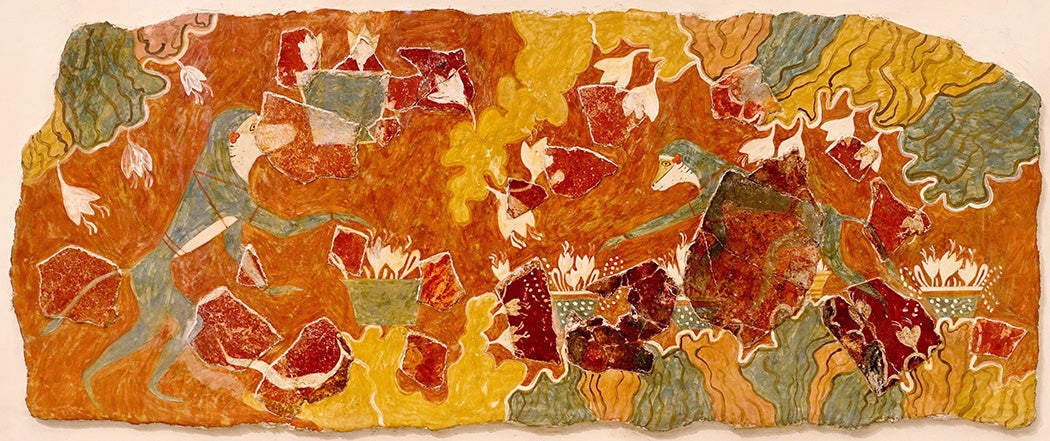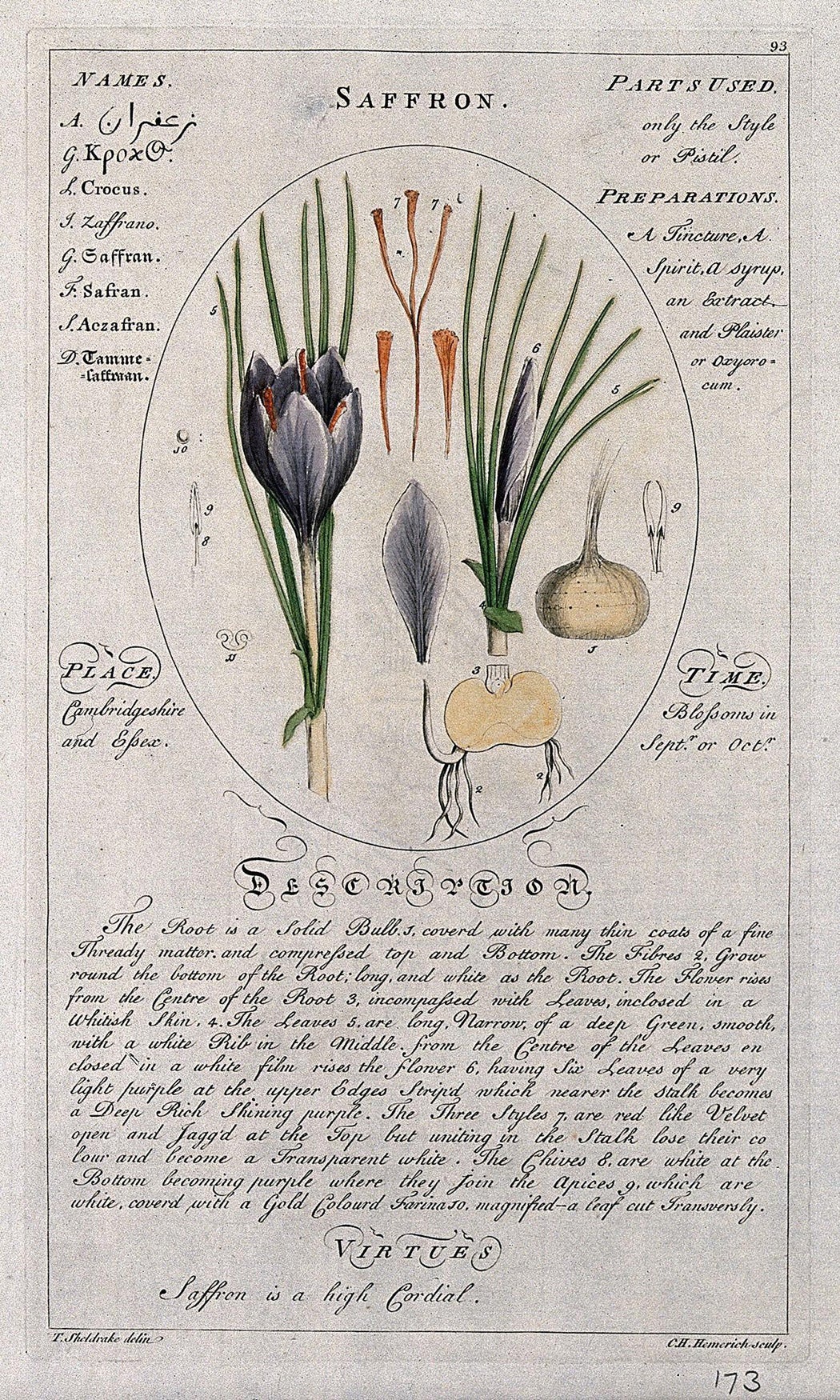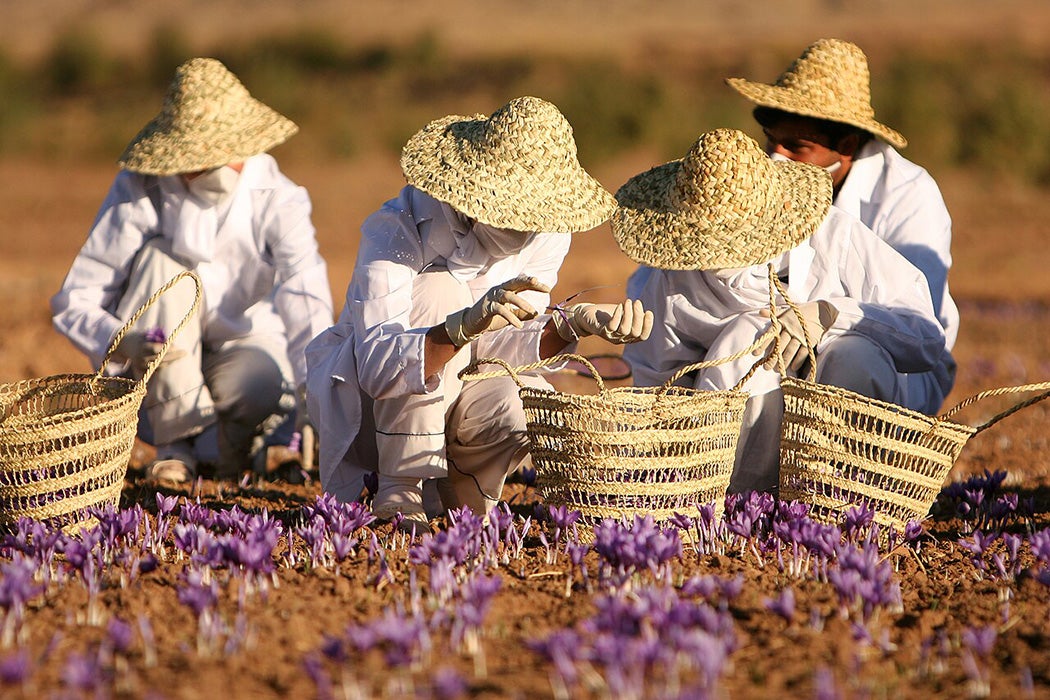Walking through the spice aisle of a grocery store in 2024, one selection stands out among the rest: saffron. At Whole Foods, 0.5g of “Hand-Harvested Saffron Threads” sells for $8. In other words, it’s expensive. It’s pricey even on internet: one website offers just ten tablespoons (ten grams) of saffron for $120.
The irony of the Whole Foods saffron is that all saffron must be hand harvested from the Crocus sativus plant, a flower that blooms purple and blue petals in the fall. Saffron is expensive not because it’s difficult to grow, but because of the labor and tedious timing necessary to extract it from the flower. The prized reddish-orange “stigmas” stem from the middle of the plant a few weeks after the flower blooms, and they must be harvested at mid-morning, when the flower is fully open to the Sun.
One gardening website describes the process of harvesting saffron as something that should be done with tweezers at a kitchen table. For centuries, saffron has been a prized dye, spice, and scent—and the harvesting process has not changed much. According to a New Zealand study discussed by William C. Waterhouse,
in a field with modern planting and fertilization routines, it takes between 70,000 and 200,000 flowers to produce one kilogram of dried saffron threads. The flowers must be picked by hand and the stigmas removed for drying, and the result is that it takes “around 370–470 hours of work to produce 1 kg of dried saffron.”
Crocus sativus was derived from the naturally occurring Crocus cartwrightianus, which likely originated in present-day Iran. The saffron we know today came from humans “selecting the specimens with exceptionally long stigmas.” Crocus sativus is sterile and doesn’t produce its own fertile seeds. Thus, humans must unearth the corms (underground reproductive roots and stems) and plant them elsewhere.
One of the earliest references to saffron dates to 2300 BCE, in The Legend of Sargon of Akkad, a Mesopotamian work that describes the birthplace of the founder of the Akkadian empire as “city of saffron.” The word “saffron” is very similar in many languages around the world. Etymologists trace the word to the Medieval Latin “safranum,” which comes from the Arabic word az-za’faran.
In 2022, using ancient art and genetics, new research published in Frontiers argued that Crocus sativus was first domesticated in Greece in approximately 1700 BCE. Many ancient Minoan art pieces depict saffron, including the fresco of blue monkeys picking saffron below. International trade brought saffron from the present-day Middle East and Mediterranean to Spain, where it was likely introduced for cultivation in 921 CE, write scientists C. L. Madan, B. M. Kapur, and U. S. Gupta in a 1966 issue of Economic Botany. Hundreds of years later, saffron could be found everywhere from the fields of England to Russia.

Crocus sativus is most famously known for its culinary properties. It’s the cornerstone flavor in many dishes from around the world, ranging from paella to biryani. Some chefs describe saffron as tasting “slightly earthy and sweet,” while giving off a “smoky aroma.”
But saffron is also prized for its medicinal and aromatic value. Dov Basker and Moshe Negbi write that Pliny the Elder, a Roman writer and naturalist, “ascribed [to saffron] general panacean properties [sic].” According to Madan et al.,
Saffron in small doses was formerly attributed with sedative, expectorant, stimulant, stomachic, antispasmodic, antihysteric, and aphrodisiac properties and was also prescribed in fevers, melancholia, and enlargement of the spleen.
In some cases, it was even used as an abortifacient.
Saffron can also be used to dye clothing items or skin. For Hindus, saffron is one of the most sacred colors, and is sometimes “applied as a red dye to the forehead,” write Madan et al. In Rome, explain Basker and Negbi, “it was used to color the marriage robe.” Buddhist monks, too, famously wear robes the color of saffron, though the robes aren’t dyed with the plant.

Crocus sativus flowers bloom in the fall for only a few days, and they must be picked in the early hours of the morning, by hand. The labor-intensive nature of the harvesting created a market where saffron is several times more expensive than many other popular spices. As archaeologist Jo Day explains, “the fifteenth-century royal house of Navarre, for example, paid eight times as much for saffron as for pepper, itself a very costly spice…”
Today, most saffron is grown in countries where workers are paid less than their Western European counterparts would need to be. The primary producers are Iran, India, and Greece. The luxury price of saffron has even spurred attempts to grow it in the United States.

Saffron isn’t a very climate-resilient plant. Though idrought-resistant and thus thriving in semi-arid regions, it fares poorly in extreme temperatures. Additionally, research suggests that “a long hot summer delay[s] flower emergence.” As the climate continues to warm, saffron could take longer to flower—thus delaying the payout for many small-scale farmers relying on their very small-yield plants. A need for economic diversification may be behind recent efforts by saffron farms to provide opportunities for tourism.
Weekly Newsletter
Crocus sativus is in many ways still as prized as it was when it was first domesticated. When humans decided the fiery stigmas in the middle of the flower were special, an entire economy emerged around the growth, harvest, and trade of the plant. Crocus sativus is one plant where mechanization has not changed the harvesting process. Such a labor-intensive harvest leads to prices that make us pause as we walk down the spice aisle.
The Plant Humanities Initiative at Dumbarton Oaks seeks to explore the relationships between plants, people, and culture.
Support JSTOR Daily! Join our membership program on Patreon today.








